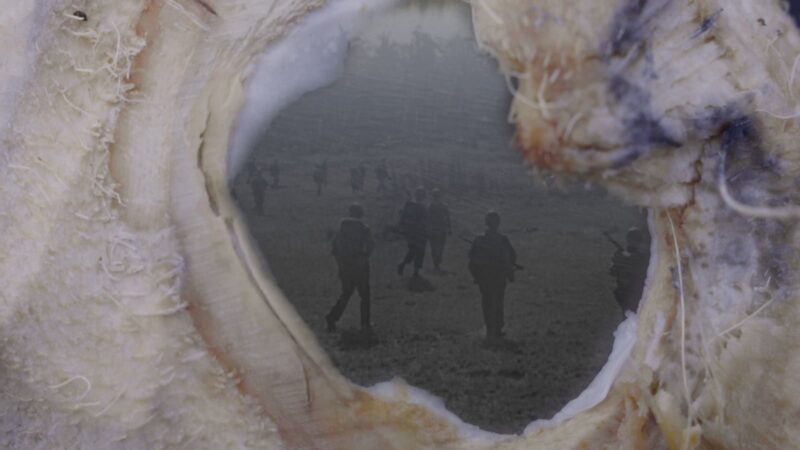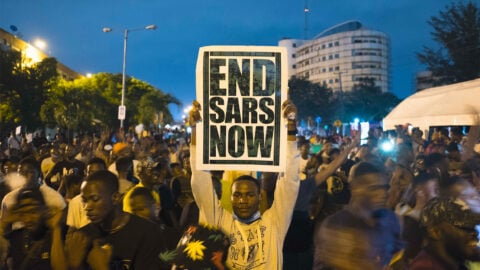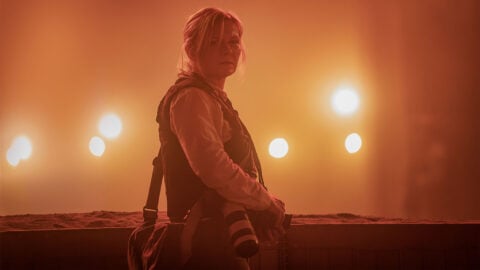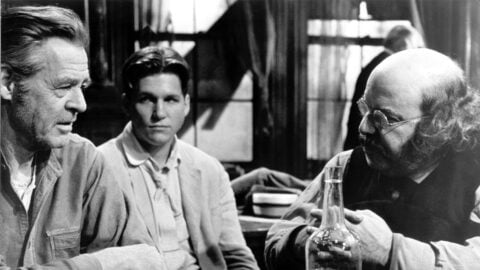Interview: Miko Revereza on Nowhere Near
This article appeared in the January 5, 2024 edition of The Film Comment Letter, our free weekly newsletter featuring original film criticism and writing. Sign up for the Letter here.

Nowhere Near (Miko Revereza, 2023)
Miko Revereza’s new feature, Nowhere Near (2023), marks the latest entry in the filmmaker’s rich body of work exploring his and his family’s experiences living as undocumented immigrants within the United States. Across his shorts—Droga! (2014), Disintegration 93-96 (2017), Quantum Identity Politics (2017), Distancing (2019)—and feature films—No Data Plan (2019) and The Still Side (2021, co-directed by Carolina Fusilier)—Revereza finds ever-new ways of thinking with images, working across diaristic, documentary, and experimental modes to weave together personal and political histories of migration. Nowhere Near, made over seven years, is both a return and a departure. In the first half of the film, Revereza sifts through his cinematic archive and interrogates the impact of the post-9/11 doctrine of national security on his family’s inability to secure their documents. In the second half of the film, Revereza leaves the United States—a decision that will render him unable to return—and travels to the Philippines with his grandmother in search of a plot of ancestral land granted to the family during the Spanish colonial period. In retracing the family’s past, they confront the fragility of memory and the legacy of the U.S. military occupation, which continues to structure their lives.
The film premiered at the Open City Documentary Festival in London last September, and, like Revereza’s other work, is self-distributed. Subsequently, its circulation and political resonance have been shaped by the escalation of Israel’s war on Gaza following the Hamas attacks on October 7. Many cultural workers have responded to this state of emergency by joining mass actions calling for a permanent cease-fire and for Palestinian liberation. In November, Revereza and over a dozen other filmmakers withdrew from the International Documentary Film Festival Amsterdam (IDFA) in protest of the festival’s insufficient response to the war on Gaza.
“My film is inherently in solidarity with [the Palestinian struggle]. It’s about occupation, it’s about empire, it’s about the generations after the bombing of my grandmother’s hometown and the ripples that are still felt today, and it’s about displacement,” Revereza told me when I interviewed him last month. “The IDFA thing was one of the most meaningful things I’ve taken part in in filmmaking. And the collective action, I think, was better than any of our films.” In our conversation, he further reflected on Nowhere Near, his creative process, and on the relationships between artists and cultural institutions.
Your films are often in dialogue with your family’s home videos. In Disintegration 93-96, you describe your dad’s home movies as films that project a dream of stability against the precarity of living undocumented. No Data Plan is in dialogue with the photos that your mom takes and sends you as she’s traveling around the U.S., which are also part of her fantasy construction of her life with her new partner. In Nowhere Near, you travel with your grandmother to Manila, and confront the differences between what she imagined and what remains; it’s really a collaboration, even though it takes your own critical perspective. How do you think about your work in relationship to this intimate material?
I really like these reads of my previous films. You’re right, Nowhere Near kind of becomes my grandmother’s home movie. I love home movies—I think that’s my favorite moving-image form. One of my favorite things to watch are the VHS tapes that my dad was shooting throughout the first few years we lived in the U.S. I just like the form, the collecting of footage that just accumulates to fill a tape. No editing is involved: it’s all in-camera. It allows for a different type of watching, where you just sit and you’re not looking for a storyline. I think that the home movies my dad made probably did affect me and my practice later on. I never really got into making fiction films—maybe I’ve just been lazy about having to construct the image and everything. I’m just interested in what’s there, in the moment, and collecting for memory, for my archive—to look back at, to recontextualize later, and also to use as fragments and poetic units that can create larger structures. I wish I could find a way of making films that feel more free, like a home movie. Like, I hate editing [laughs].
You really feel that sense of accumulation in the film itself, in the way you return to your own visual archive, and through the use of superimposition, which you’ve spoken about through the metaphor of “packing a suitcase”—as a means of condensing the filmic material but also opening it up to new associations.
All the films that I’ve made thus far feel like they could be the same project, with just an evolution of the form. Maybe it’s the same story, but I’m trying different ways of telling it, editing it differently, designing the sound differently. And with each of the films, the narration takes a different approach. For this film in particular, the voiceover was the most difficult and time-consuming thing. Each of the films has been a negotiation of how to present my voice, or a process of finding my voice. And I think in Nowhere Near, it really feels like I went all in on that, on presenting my voice.
There is also going to be a book version of Nowhere Near that will be published by Wendy’s Subway in 2024. What’s the relationship between the book and the filmic narrative? How does your writing process intersect with your filmmaking process?
I wrote this book while editing this film. It became the voiceover narration for the film, but in order to have the material for the narration, I had to write this book in full. So I spent maybe six or eight months just sitting down, at a typewriter, every morning and just typing out memories or thinking about the footage. It’s the first book that I’ve written. It’s novel-length, and I was surprised by its coming together. The book has a lot that’s not in the film; it’s a piece of literature, but it does talk about the film and the process of filmmaking.
A typewriter really helped me with my daily quota because of the lack of a backspace key: you just fill one page a day and move on. It’s similar to capturing footage. It felt actually like the writing process was an image-making process, but an interior image-making process. It involves similar forms of editing—the mind can leap, and footnote, and go meta into an image, and then to another image. After I wrote the book, I started to think about the images that I can’t film, and how the way to go about it is just to write them. Like, when I’m in a bureaucratic office, I can’t have a camera, but I can just write the scenes.
You withdrew your film from IDFA in November in solidarity with Palestine, and have, across many interviews, reflected on the negotiations that marginalized filmmakers must undertake in their relationships to film institutions. Can you tell me about the boycott, and how you are approaching navigating these spaces and showing your film now?
With what’s going on in Gaza right now, and the climate of censorship in art and cultural institutions, especially in Germany and even in the U.S. and the U.K., I think the negotiation has changed. When working with an institution, it’s a collaboration; there’s the trust of being aligned. That’s the most important part. If a museum or an institution is really about a decolonial discourse, why is it that right now, when it pertains to Palestinians, that’s not the case? All of a sudden, I feel like a mask has fallen off of institutions. Before, these were spaces we navigated as artists of color. We brought our particular fraught backgrounds and our politics and exhibited them in these institutions. We gain something, and the institution gains something in the display of a progressive politics. But now everyone is reconsidering that relationship.
I was one of the first filmmakers to withdraw from IDFA. I was traveling from Mumbai back to Mexico when that happened. When I was watching my film at the [Jio MAMI] Mumbai Film Festival, it really struck me in a new way—in watching the U.S. bombs on my grandmother’s hometown, seeing footage from World War II, I saw what’s happening now. Traveling back, I was just thinking, “What can I do as a humble experimental filmmaker? How can I contribute? What are the assets I have?” I thought, “I’m going to suggest to IDFA that I’m not going to send my DCP, the screening file, until they make a statement calling for a cease-fire and stand in solidarity with the Palestinian people.” Because they hadn’t made a statement. Then I saw an Instagram post by the group Workers for Palestine Netherlands about their protest [at the opening night of IDFA], and they were chanting onstage, “Institutional silence is violence,” calling out IDFA for having been silent all this time. It just made me pull the trigger and withhold the DCP. I think that protest was the first domino that inspired a lot of us who were taking part in IDFA to do something more with our films. And that was the important part—films have power outside of the screen, you know? It is the asset we can leverage. It’s in our control if it gets screened or not. So it was amazing to just see the leveraging of that power, as individual filmmakers one-by-one withdrew their projects in support of Palestine.
Katie Kirkland is a Brooklyn-based writer and a PhD candidate in film studies and comparative literature at Yale University.







